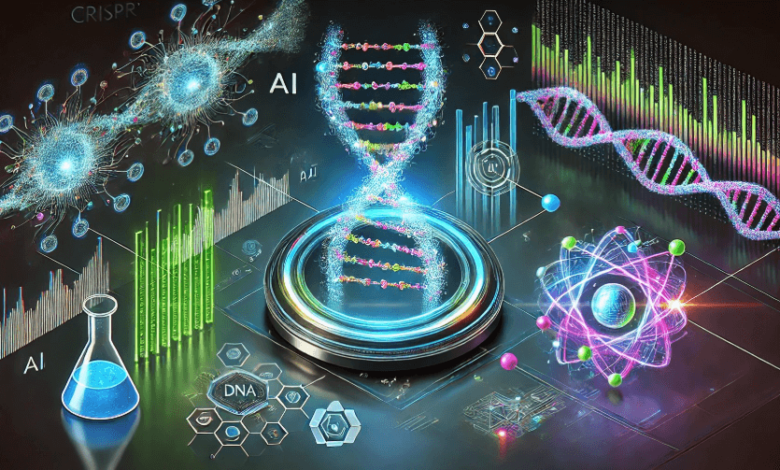The Genetic Blueprint: Revolutionizing Life Sciences with CRISPR

CRISPR, a groundbreaking gene-editing technology, is transforming the life sciences landscape. Short for Clustered Regularly Interspaced Short Palindromic Repeats, CRISPR enables precise editing of DNA, opening doors to revolutionary advancements in medicine, agriculture, and biotechnology. From curing genetic disorders to engineering resilient crops, this technology is reshaping how we understand and manipulate the blueprint of life. This article delves into the origins of CRISPR, its scientific principles, applications, ethical considerations, and the future of this transformative tool.
The Origins of CRISPR
CRISPR was discovered as a natural defense mechanism used by bacteria to fend off viruses. In the late 1980s, scientists observed repetitive DNA sequences in bacterial genomes. It wasn’t until 2007 that researchers confirmed these sequences were part of an adaptive immune system that bacteria used to recognize and destroy viral DNA. The turning point came in 2012 when Jennifer Doudna and Emmanuelle Charpentier demonstrated how CRISPR could be adapted for targeted gene editing. Their pioneering work earned them the Nobel Prize in Chemistry in 2020, solidifying CRISPR’s status as a game-changer in biotechnology.
How CRISPR Works
At its core, CRISPR functions as a molecular pair of scissors. It uses a protein called Cas9 (or similar variants) and a guide RNA to target and cut specific DNA sequences.
Key Components of CRISPR
- Guide RNA (gRNA): Designed to match the target DNA sequence, directing Cas9 to the precise location for editing.
- Cas9 Protein: Acts as a molecular scissor, cutting the DNA strand at the desired site.
- Repair Mechanisms: After the cut, natural cellular processes repair the DNA, enabling scientists to delete, insert, or modify genetic material.
This precise editing capability makes CRISPR a versatile tool for research and applications across various fields.
Applications of CRISPR in Medicine
CRISPR is revolutionizing medicine by offering potential cures for previously untreatable genetic conditions. CRISPR is being used to treat genetic disorders such as sickle cell disease by editing bone marrow cells to correct the faulty gene responsible for the disorder. Researchers are exploring its use to repair the defective gene causing cystic fibrosis. CRISPR is enhancing cancer therapies by engineering immune cells to recognize and destroy tumors more effectively. The technology is being tested to combat viral infections like HIV by removing viral DNA embedded in human genomes. Additionally, CRISPR is being used to edit pig genomes to make organs compatible for human transplantation, addressing the critical shortage of donor organs.
Agricultural Advancements with CRISPR
CRISPR’s potential extends far beyond medicine, significantly impacting agriculture and food production. CRISPR enables the development of crops with enhanced traits such as drought resistance, by editing genes to make plants more resilient to water scarcity, and nutritional enhancement, by fortifying crops like rice with essential nutrients to combat malnutrition. Farmers are leveraging CRISPR to create pest-resistant crops, reducing the need for chemical pesticides. In livestock editing, CRISPR is being used to breed disease-resistant animals and improve meat quality and production efficiency.
CRISPR in Biotechnology and Beyond
In the biotechnology sector, CRISPR is fostering innovations that were once considered science fiction. Scientists are engineering microorganisms to produce biofuels, biodegradable plastics, and pharmaceuticals using CRISPR. CRISPR-based gene drives are being developed to control populations of disease-carrying organisms like mosquitoes, potentially eradicating malaria and other vector-borne diseases. The technology is being explored to help revive extinct species and protect endangered ones by editing genomes to enhance survival traits.
Ethical Considerations in CRISPR Technology
Despite its immense potential, CRISPR raises significant ethical and societal questions. Editing germline cells (which pass changes to offspring) poses moral dilemmas about designer babies and unintended consequences. CRISPR-based treatments are expensive and may exacerbate global healthcare inequalities if not made accessible to all. Unintended edits can have unpredictable consequences, emphasizing the need for rigorous safety measures. Gene drives and genetic modifications may disrupt ecosystems, requiring careful consideration of long-term effects.
Challenges in CRISPR Development
CRISPR is not without its challenges, and addressing these hurdles is crucial for its widespread adoption. Efficiently delivering CRISPR components to specific cells or tissues remains a major obstacle. Techniques like viral vectors and lipid nanoparticles are under development to improve delivery methods. Governments worldwide are grappling with creating guidelines to regulate CRISPR’s use while encouraging innovation. Misinformation and ethical concerns have led to skepticism, highlighting the need for transparent communication about CRISPR’s benefits and risks.
The Future of CRISPR
CRISPR’s future is bright, with ongoing advancements promising to unlock even greater possibilities. An evolution of CRISPR, prime editing offers even more precision and fewer errors, enabling complex genetic modifications. International partnerships are driving large-scale CRISPR projects, such as eradicating diseases and tackling food security challenges. CRISPR could enable tailored treatments for individuals based on their unique genetic profiles, heralding a new era in precision healthcare.
Conclusion
CRISPR represents a paradigm shift in the life sciences, empowering humanity to rewrite the genetic blueprint of life. From curing diseases to solving global challenges like hunger and climate change, its applications are as vast as they are transformative. However, the ethical and practical challenges associated with CRISPR must be addressed to ensure its benefits are realized responsibly. As the technology continues to evolve, its impact will undoubtedly shape the future of science, health, and society.
FAQs
1. What is CRISPR, and how does it work?
CRISPR is a gene-editing technology that uses a guide RNA and the Cas9 protein to precisely target and modify DNA sequences.
2. What diseases can CRISPR potentially cure?
CRISPR shows promise in treating genetic disorders like sickle cell anemia, cystic fibrosis, and certain cancers.
3. How is CRISPR used in agriculture?
CRISPR enhances crops by making them pest-resistant, drought-tolerant, and nutritionally enriched.
4. What are the ethical concerns surrounding CRISPR?
Key issues include germline editing, equity in access, off-target effects, and potential ecological disruptions.
5. What advancements are expected in CRISPR technology?
Future developments include prime editing, improved delivery systems, and applications in personalized medicine.
6. How can CRISPR impact biodiversity conservation?
CRISPR can help protect endangered species and even revive extinct ones by enhancing survival traits and correcting genetic defects.




